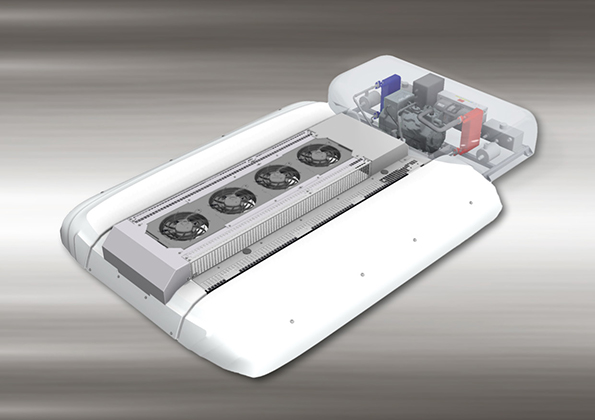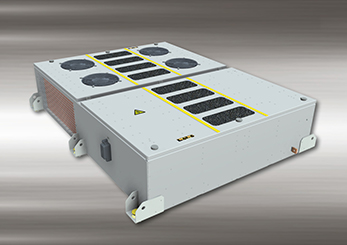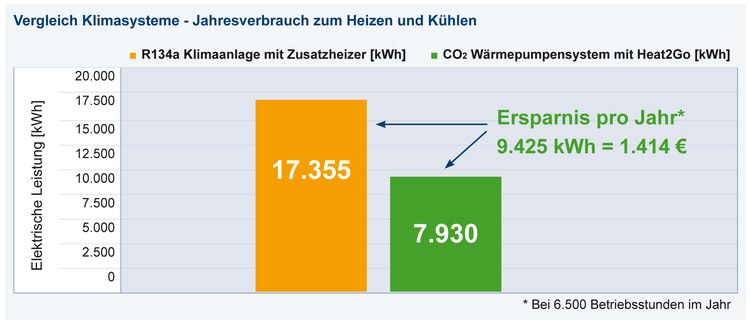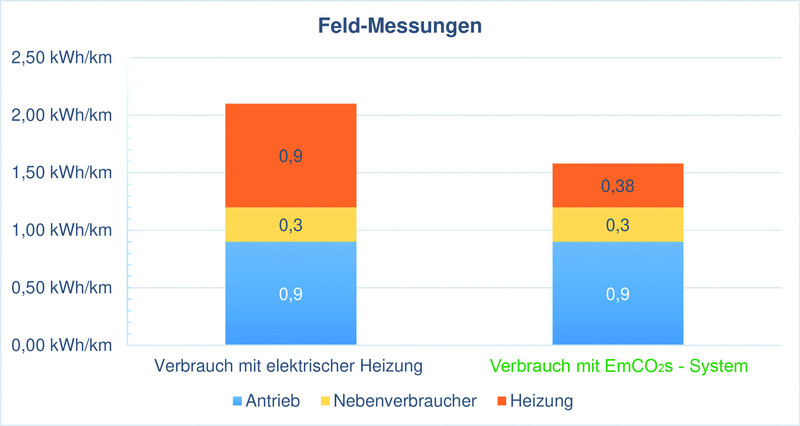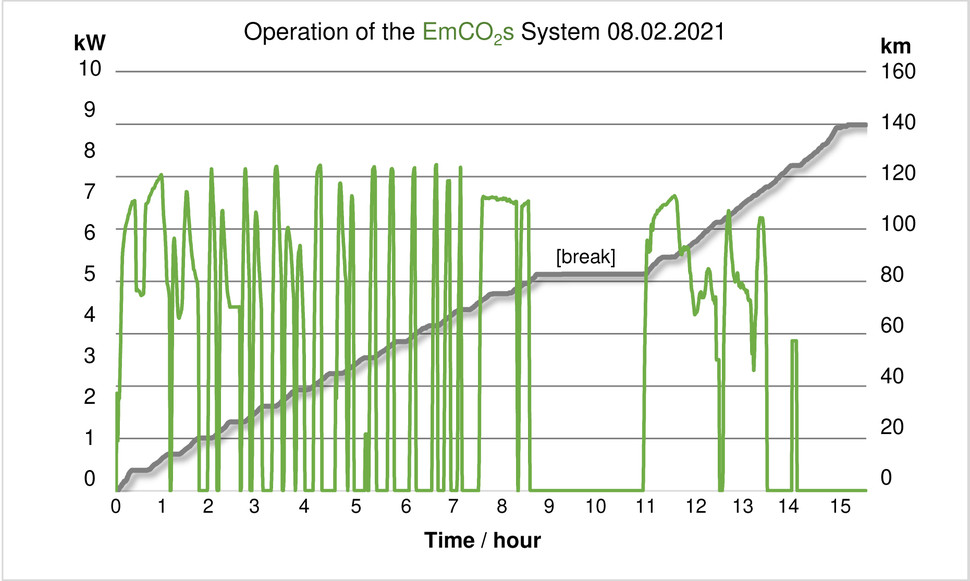Konvekta CO2 heat pump variants for electric buses and rail vehicles
Reliable and efficient.
Electromobility is the future, but there are still many aspects that need to be dealt with. One of the key issues is the range that needs to be increased by continuously optimising all components. What’s more, electric buses do not produce waste heat that can be used to heat the passenger compartment. Electromobility therefore requires highly efficient auxiliary consumers and an integrated heating and cooling strategy.
The idea: an air-conditioning system for electric buses that increases the range and saves money on service and maintenance while adding ecological value at the same time.
The result: an integrated thermal management system for electric buses – 100% needs-based and customisable with maximum efficiency – the Konvekta CO2 heat pump.
The principle is actually quite simple: heat or cold is extracted from a natural source of energy (air) to be used for heating in winter or cooling in summer.
1 KW energy becomes 4 KW power. (COP Coefficient of Performance = 3)
The Konvekta CO2 heat pump uses CO2 (R-744) as carrier.
The CO2 (R-744) refrigerant assumes the task of transmitting or transporting heat or cold in the circuit of the heat pump.
The Konvekta CO2 heat pump system
The new Konvekta CO2 heat pump 2.0 is a comprehensive and load-synchronous thermal management system. This system consists of the roof unit and two new Konvekta energy carrier modules. The desired auxiliary consumers can be heated or cooled at the same time with these new components. For example, the front box and convectors in the interior can be heated and the batteries can be cooled at the same time. This way the second generation Konvekta CO2 heat pump can be customised to fit all bus types.
Further energy requirements are achieved through:
- refrigerant CO2 (R744)
- components developed in-house (e.g. heat exchangers)
- Energy Collect (Heat recovery from heat-generating components = 15 -20% energy savings)
- Konvekta control unit "CleverControl"
The energy consumption in comparison shows that of the possible variants of air conditioning an electric bus, the CO2 heat pump is the most energy-efficient.
Cost and environmental saving potential - energy consumption

The heat pump reduces energy consumption with zero emissions e.g. by 60% at -10°C in comparison to classic electric heating systems.
If you look at the entire year, including air conditioning, the energy requirement is reduced by more than 50%.
Increasing the range
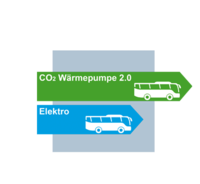
These energy savings could be used to increase the range. The increase in range depends upon the weather conditions and the type of the vehicle.
Increasing the range up to 60 %
Cost savings and environmental benefits

The heat pump requires a maximum of 50% of the drive power in comparison to an electrical heating device, therefore only half of the additional installed battery capacity will be required. Including the battery change that is required, this results a
Saving of € 18.250 (in addition, the service life of the batteries will be increased)
The batteries can also be designed smaller, and at the same time their service life will ne increased. This represents another major benefit for the environment and a considerable cost saving.
100% climate coverage per year means:
Every system needs additional heating. The only question is how often you need additional heating.
If you look at the average climate in Germany, you can see that there is a temperature window from -13 ° C to 35. (travel time from 5:00 to 23:00)
The Konvekta CO2 heat pump 2.0 covers 100% of this window. That means: even at an outside temperature of -20 ° C it is pleasantly warm inside the vehicle and in summer it is still pleasantly cool even at 47 ° C.
With the other variants, additional heating is required very early on, this costs money or reduces the range of the vehicle. The Konvekta CO2 heat pump requires no additional diesel heating and therefore no fossil fuels (e.g. diesel fuel).
That means: there are no costs for heating the vehicle and no exhaust gases.
Other systems (e.g. a heat pump with R134a) very often require additional heating energy each year to air-condition the passenger compartment. This creates high costs. To heat a city bus for one year, you need the same fuel requirement as for a small family home.
Distribution of Konvekta CO2 heat pumps
The Konvekta CO2 heat pump systems have been available on the market successfully as a series product since 2018. Already in use all over Europe - from Sweden to Great Britain to Italy, CO2 heating and air conditioning systems from Konvekta prove efficiency and economy every day. More than 1,300 buses and rail vehicles are currently in use with the alternative refrigerant CO2. Over 100 transport companies in over 40 countries use the systems in their bus fleets
Also today, snowfall will be responsible for significant traffic disruptions in large parts. According to the German Weather Service, permafrost, ten centimeters of fresh snow and temperatures up to -10° are to be expected." - this is how the weather looked on 08th February this year. Optimal conditions to test and evaluate the new EmCO2s system - Ecological Mobile CO2 System of Konvekta AG.
A number of 12-meter city buses were tested in an area with medium topography in Germany. The vehicles were in operation for approximately 14 hours (including one break). The driving distance was approximately 140 km per day and the vehicles were not preconditioned. The data was collected across the entire vehicle system - from the engine and auxiliary consumers to the air conditioning components. The analyses showed that after a short warm-up phase in the morning and after the break, the system ran evenly, and the indoor set temperature of 20 °C was reached without any problems throughout the day. The vehicles with an EmCO2s system, as an overall system with optimally matched components, consumed only 1.58 kWh/km. A system with purely electric heating requires 2.15 kWh/km under the same conditions. At these low temperatures, the electric buses with an EmCO2s system were thus able to save around 27% energy or increase their range by 27%.
Potential savings of service costs by 70 %.
In the area of service and maintenance, CO2 results in considerable cost and time savings. This is because there is no need to recover or dispose of this refrigerant (R744) after any maintenance or repair work.
The simple and safe handling of the R-744 means that service times are reduced by more than half compared to the R-134a. Since R-744 is not a chemical refrigerant, it is not subject to the ChemKlimaSchutzVO.
The acquisition costs for the refrigerant per kg are over 90% lower.
Another benefit is the use of UltraLight technology. The extremely light and stable high-performance material forms the basis for holding all components, which makes exchanging components extremely easy. Filters, fans and other components are replaced in a few seconds.
This results in an overall saving in service costs of approx. 70%.

